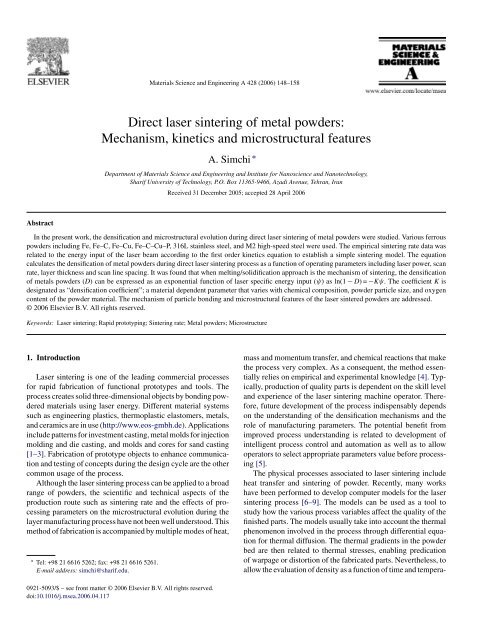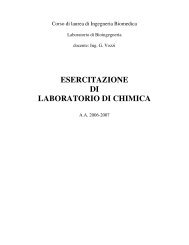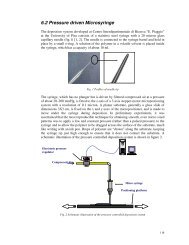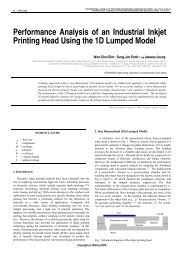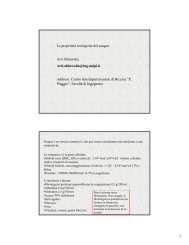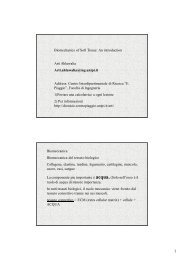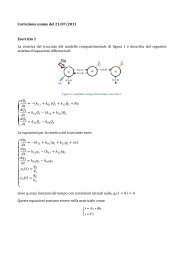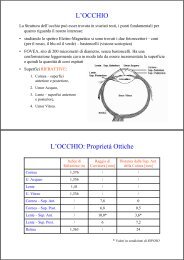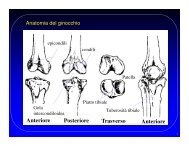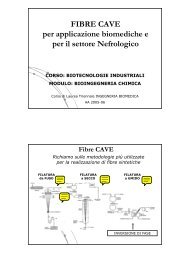Direct laser sintering of metal powders: Mechanism, kinetics and ...
Direct laser sintering of metal powders: Mechanism, kinetics and ...
Direct laser sintering of metal powders: Mechanism, kinetics and ...
- No tags were found...
You also want an ePaper? Increase the reach of your titles
YUMPU automatically turns print PDFs into web optimized ePapers that Google loves.
Materials Science <strong>and</strong> Engineering A 428 (2006) 148–158<strong>Direct</strong> <strong>laser</strong> <strong>sintering</strong> <strong>of</strong> <strong>metal</strong> <strong>powders</strong>:<strong>Mechanism</strong>, <strong>kinetics</strong> <strong>and</strong> microstructural featuresA. Simchi ∗Department <strong>of</strong> Materials Science <strong>and</strong> Engineering <strong>and</strong> Institute for Nanoscience <strong>and</strong> Nanotechnology,Sharif University <strong>of</strong> Technology, P.O. Box 11365-9466, Azadi Avenue, Tehran, IranReceived 31 December 2005; accepted 28 April 2006AbstractIn the present work, the densification <strong>and</strong> microstructural evolution during direct <strong>laser</strong> <strong>sintering</strong> <strong>of</strong> <strong>metal</strong> <strong>powders</strong> were studied. Various ferrous<strong>powders</strong> including Fe, Fe–C, Fe–Cu, Fe–C–Cu–P, 316L stainless steel, <strong>and</strong> M2 high-speed steel were used. The empirical <strong>sintering</strong> rate data wasrelated to the energy input <strong>of</strong> the <strong>laser</strong> beam according to the first order <strong>kinetics</strong> equation to establish a simple <strong>sintering</strong> model. The equationcalculates the densification <strong>of</strong> <strong>metal</strong> <strong>powders</strong> during direct <strong>laser</strong> <strong>sintering</strong> process as a function <strong>of</strong> operating parameters including <strong>laser</strong> power, scanrate, layer thickness <strong>and</strong> scan line spacing. It was found that when melting/solidification approach is the mechanism <strong>of</strong> <strong>sintering</strong>, the densification<strong>of</strong> <strong>metal</strong>s <strong>powders</strong> (D) can be expressed as an exponential function <strong>of</strong> <strong>laser</strong> specific energy input (ψ) as ln(1 − D)=−Kψ. The coefficient K isdesignated as “densification coefficient”; a material dependent parameter that varies with chemical composition, powder particle size, <strong>and</strong> oxygencontent <strong>of</strong> the powder material. The mechanism <strong>of</strong> particle bonding <strong>and</strong> microstructural features <strong>of</strong> the <strong>laser</strong> sintered <strong>powders</strong> are addressed.© 2006 Elsevier B.V. All rights reserved.Keywords: Laser <strong>sintering</strong>; Rapid prototyping; Sintering rate; Metal <strong>powders</strong>; Microstructure1. IntroductionLaser <strong>sintering</strong> is one <strong>of</strong> the leading commercial processesfor rapid fabrication <strong>of</strong> functional prototypes <strong>and</strong> tools. Theprocess creates solid three-dimensional objects by bonding powderedmaterials using <strong>laser</strong> energy. Different material systemssuch as engineering plastics, thermoplastic elastomers, <strong>metal</strong>s,<strong>and</strong> ceramics are in use (http://www.eos-gmbh.de). Applicationsinclude patterns for investment casting, <strong>metal</strong> molds for injectionmolding <strong>and</strong> die casting, <strong>and</strong> molds <strong>and</strong> cores for s<strong>and</strong> casting[1–3]. Fabrication <strong>of</strong> prototype objects to enhance communication<strong>and</strong> testing <strong>of</strong> concepts during the design cycle are the othercommon usage <strong>of</strong> the process.Although the <strong>laser</strong> <strong>sintering</strong> process can be applied to a broadrange <strong>of</strong> <strong>powders</strong>, the scientific <strong>and</strong> technical aspects <strong>of</strong> theproduction route such as <strong>sintering</strong> rate <strong>and</strong> the effects <strong>of</strong> processingparameters on the microstructural evolution during thelayer manufacturing process have not been well understood. Thismethod <strong>of</strong> fabrication is accompanied by multiple modes <strong>of</strong> heat,∗ Tel: +98 21 6616 5262; fax: +98 21 6616 5261.E-mail address: simchi@sharif.edu.mass <strong>and</strong> momentum transfer, <strong>and</strong> chemical reactions that makethe process very complex. As a consequent, the method essentiallyrelies on empirical <strong>and</strong> experimental knowledge [4]. Typically,production <strong>of</strong> quality parts is dependent on the skill level<strong>and</strong> experience <strong>of</strong> the <strong>laser</strong> <strong>sintering</strong> machine operator. Therefore,future development <strong>of</strong> the process indispensably dependson the underst<strong>and</strong>ing <strong>of</strong> the densification mechanisms <strong>and</strong> therole <strong>of</strong> manufacturing parameters. The potential benefit fromimproved process underst<strong>and</strong>ing is related to development <strong>of</strong>intelligent process control <strong>and</strong> automation as well as to allowoperators to select appropriate parameters value before processing[5].The physical processes associated to <strong>laser</strong> <strong>sintering</strong> includeheat transfer <strong>and</strong> <strong>sintering</strong> <strong>of</strong> powder. Recently, many workshave been performed to develop computer models for the <strong>laser</strong><strong>sintering</strong> process [6–9]. The models can be used as a tool tostudy how the various process variables affect the quality <strong>of</strong> thefinished parts. The models usually take into account the thermalphenomenon involved in the process through differential equationfor thermal diffusion. The thermal gradients in the powderbed are then related to thermal stresses, enabling predication<strong>of</strong> warpage or distortion <strong>of</strong> the fabricated parts. Nevertheless, toallow the evaluation <strong>of</strong> density as a function <strong>of</strong> time <strong>and</strong> tempera-0921-5093/$ – see front matter © 2006 Elsevier B.V. All rights reserved.doi:10.1016/j.msea.2006.04.117
A. Simchi / Materials Science <strong>and</strong> Engineering A 428 (2006) 148–158 149NomenclatureC heat capacity (J/kg K)d beam diameter (mm)D n particle size at n pct <strong>of</strong> the cumulative particle sizedistribution (m)h scan line spacing (mm)H latent heat <strong>of</strong> fusion (J/kg)K densification coefficient, Eq. (10)k ′ <strong>sintering</strong> ratel scan vector length (mm)O fraction <strong>of</strong> overlap, Eq. [3]P <strong>laser</strong> power (W)Q <strong>laser</strong> energy density (J/mm 2 )¯Q delivered energy per volume <strong>of</strong> each <strong>laser</strong> track(J/mm 3 )S w particle size distribution slopeT temperature (K)v scan rate (mm/s)v ∗ dimensionless velocityw layer thickness (mm)Greek symbolsε void fractionρ fractional densityτ delay period between successive irradiationψ <strong>laser</strong> energy input per volume <strong>of</strong> sintered specimen(kJ/mm 3 )η coupling efficiencySubscriptsb bedo initials <strong>sintering</strong>ture <strong>and</strong> thus on the process variables, it is important to developa <strong>sintering</strong> model. A <strong>sintering</strong> model allows one to perform aparametric analysis to study how variations in one parameteraffect the sintered density or <strong>sintering</strong> depth within a powderbed.In the indirect <strong>laser</strong> <strong>sintering</strong> process, i.e. selective <strong>laser</strong> <strong>sintering</strong>,which originated by the University <strong>of</strong> Texas at Austin,a polymer phase is used for powder particles bonding. During<strong>laser</strong> irradiation, the polymer phase is melted <strong>and</strong> upon cooling,it bonds the powder particles together [10]. The <strong>sintering</strong> mechanismis viscous flow <strong>and</strong> the surface energy reduction drivesthe mass flow dissipation. Although modeling <strong>of</strong> <strong>laser</strong> <strong>sintering</strong>rates for real systems is difficult <strong>and</strong> in many cases may not provideaccurate results, isothermal <strong>sintering</strong> rates <strong>of</strong> amorphousmaterials can be used. For instance, Nelson [11] assumed thatthe <strong>sintering</strong> rate is a function <strong>of</strong> temperature according to Arrheniusequation. Sun [12] related the <strong>sintering</strong> height to the <strong>laser</strong>power <strong>and</strong> <strong>laser</strong> velocity by simple empirical equations. Bugedaet al. [13] considered the powder bed as an open pore network<strong>of</strong> cylinders <strong>and</strong> evaluated the sintered density as a function <strong>of</strong>time <strong>and</strong> temperature according to the Mackenzie–Shuttleworthmodel.Unlike polymer materials, liquid phase <strong>sintering</strong> <strong>and</strong> melting/solidificationapproach are the mechanisms feasible for rapidbonding <strong>of</strong> powder particles in the direct <strong>laser</strong> <strong>sintering</strong> process(DMLS) [10]. So far, no much work has been performedto systematically investigate the <strong>sintering</strong> rate <strong>and</strong> densification<strong>of</strong> <strong>metal</strong> <strong>powders</strong> during DMLS. Since the process is very fast<strong>and</strong> complex, the existing isothermal <strong>sintering</strong> models are notadequate. For advanced theoretical <strong>and</strong> simulation studies, it isimperative to underst<strong>and</strong> the <strong>sintering</strong> mechanism <strong>and</strong> <strong>kinetics</strong>.The effect <strong>of</strong> processing parameters on the microstructuralfeatures need to be established. This study is focused on parametersinvolved in determining the method <strong>of</strong> energy delivered tothe powder medium, <strong>and</strong> to relate them to the <strong>sintering</strong> rate.Based on the empirical results, the mechanism <strong>of</strong> densification<strong>and</strong> microstructural evolution during DMLS are addressed.Although ferrous <strong>powders</strong> were used in the present work, theresults are generic <strong>and</strong> can be applied for other <strong>metal</strong> <strong>powders</strong>.2. ExperimentalTable 1 gives the particle characteristics <strong>of</strong> iron <strong>and</strong> steel<strong>powders</strong> used as the starting materials. The particle size distributionwas determined using a Coulter LS130 (Beckman CoulterGmbH, Krefeld, Germany) <strong>laser</strong> particle size analyzer. Exceptcarbonyl iron powder, the other iron <strong>powders</strong> were produced bythe water atomization process. In this case, sieving was usedto obtain different particle sizes ranging from 10 to 200 m.Graphite (2 m, Aldrich), copper (
150 A. Simchi / Materials Science <strong>and</strong> Engineering A 428 (2006) 148–15830 min to obtain steels with different chemical compositions.Here, carbon steels (up to 1.2 wt% C) <strong>and</strong> ternary Fe–C–X(X = Cu, P) alloys were prepared. Prealloyed <strong>powders</strong> <strong>of</strong> 316Lstainless steel <strong>and</strong> M2 high-speed steel (HSS) were also suppliedfrom Osprey Metals Ltd., UK. The method <strong>of</strong> powder productionwas gas atomization. The carbonyl <strong>and</strong> gas atomized <strong>powders</strong>have near spherical shape whilst the water-atomized iron <strong>powders</strong>have irregular particles.The prepared <strong>powders</strong> were sintered layer by layer torectangular test specimens with dimensions <strong>of</strong> 10 mm ×10 mm × 7 mm using EOS M250X tend machine (Electro OpticalSystems GmbH, Germany). The detail <strong>of</strong> the <strong>laser</strong> <strong>sintering</strong>operation was described elsewhere [14]. The investigated <strong>laser</strong><strong>sintering</strong> condition were <strong>laser</strong> power P = 100–215 W, scan ratev = 50–600 mm s −1 , layer thickness w = 0.05–0.2 mm <strong>and</strong> scanline spacing h = 0.1–0.4 mm. An alternative scanning patternfrom layer to layer with equal line spacing in the X <strong>and</strong> Y directionswas used. The diameter (d) <strong>of</strong> the <strong>laser</strong> beam was 0.4 mm.The building process was performed under nitrogen atmosphere<strong>and</strong> the parts were built on a low-carbon steel plate. The powderbed temperature was kept constant at 80 ◦ C during <strong>laser</strong><strong>sintering</strong>.After removing the samples from the build plate, the density<strong>of</strong> the specimens was measured by the water displacement(Archimedes) <strong>and</strong> volumetric methods. Each processing conditionwas repeated at least twice <strong>and</strong> the result <strong>of</strong> the densitymeasurement was expressed using the mean value. The st<strong>and</strong>arddeviation is less than 0.05 g/cm 3 . The surfaces <strong>of</strong> the as-sinteredsamples were observed in a LEO 438VP scanning electronmicroscopy (SEM). Samples for <strong>metal</strong>lographic examinationTable 2<strong>laser</strong> sintered density <strong>of</strong> the investigated <strong>powders</strong>Material Laser power (W) Scan rate (mm s −1 ) Layer thickness (mm) Line spacing (mm) Fractional density (%)Fe 215 75 0.1 0.1 73.8192 75 0.1 0.1 73.8215 75 0.1 0.3 72.0192 75 0.1 0.3 71.0180 75 0.1 0.3 69.7162 75 0.1 0.3 68.5144 75 0.1 0.3 68.0125 75 0.1 0.3 67.4Fe–0.8C 215 75 0.1 0.3 76.5192 75 0.1 0.3 75.0180 75 0.1 0.3 74.5162 75 0.1 0.3 73.1144 75 0.1 0.3 71.8125 75 0.1 0.3 70.0100 75 0.1 0.3 66.9215 50 0.1 0.3 78.1215 100 0.1 0.3 72.2215 125 0.1 0.3 71.4215 150 0.1 0.3 67.8215 200 0.1 0.3 64.2215 250 0.1 0.3 60.5Fe–4Cu 215 75 0.1 0.3 74.9180 75 0.1 0.3 73.8144 75 0.1 0.3 70.7100 75 0.1 0.3 56.6Fe–0.8C–4Cu–0.4P 215 75 0.1 0.3 80.6180 75 0.1 0.3 78.0144 75 0.1 0.3 75.0100 75 0.1 0.3 67.7166 300 0.1 0.3 59.0166 400 0.1 0.3 54.1166 500 0.1 0.3 51.3166 600 0.1 0.3 49.4316L 215 50 0.05 0.3 93.6215 100 0.05 0.3 86.9M2 200 50 0.1 0.3 88.2200 75 0.1 0.3 85.8200 100 0.1 0.3 84.5200 125 0.1 0.3 79.2200 150 0.1 0.3 76.6200 175 0.1 0.3 62.1
were prepared using st<strong>and</strong>ard techniques <strong>and</strong> etched in 2% Nitalreagent (2 ml HNO 3 per 100 ml CH 3 OH).3. ResultsA. Simchi / Materials Science <strong>and</strong> Engineering A 428 (2006) 148–158 151In Table 2, the sintered density <strong>of</strong> investigated <strong>powders</strong>obtained at various <strong>laser</strong> <strong>sintering</strong> condition was summarized.The results reveal that the sintered density depends on both powdercharacteristics <strong>and</strong> the fabrication parameters. In general, asthe energy input increases (higher <strong>laser</strong> power, P, or lower scanrate, v) higher density is obtained. Fig. 1 shows the fractionaldensity <strong>of</strong> investigated <strong>powders</strong> as a function <strong>of</strong> P/v. To a firstapproximation, it seems that the density is linearly proportionto the ratio <strong>of</strong> <strong>laser</strong> power to scan rate in semi-log scale. FromTable 2, one may also notice that the density depends on the layerthickness (w) <strong>and</strong> scan line spacing (h). Fig. 2 shows the effect<strong>of</strong> these parameters on the sintered density <strong>of</strong> iron powder withD 50 =51m. As it is seen, with increasing the layer thicknesslower density is achieved. Also, with decreasing the line scanspacing higher density is obtained. Nevertheless, as it was shownelsewhere [15], at high <strong>laser</strong> energy inputs delamination <strong>of</strong> sinteredlayers <strong>and</strong> formation <strong>of</strong> large cracks are feasible (Fig. 3).This may lead to lower value <strong>of</strong> the sintered density measured.In conclusion, the results <strong>of</strong> the experiments determine a greatinfluence <strong>of</strong> fabrication parameters on the densification <strong>of</strong> <strong>metal</strong><strong>powders</strong> in DMLS process.Other important factors which influence the densificationduring <strong>laser</strong> <strong>sintering</strong> are related to powder characteristics. AsTable 2 shows, the amount <strong>of</strong> densification highly depends onthe materials composition. Addition <strong>of</strong> elements such as carbon,phosphorous <strong>and</strong> copper enhances the <strong>sintering</strong> rate <strong>of</strong> ironpowder at a given fabrication condition (Fig. 1). The results alsoindicate that the densification rate <strong>of</strong> high-alloy steels, e.g. 316L<strong>and</strong> M2, is more than that <strong>of</strong> iron <strong>and</strong> low-alloy <strong>powders</strong> processedat the same condition. This observation highlights theFig. 2. Effect <strong>of</strong> layer thickness <strong>and</strong> scan line spacing on the fractional density<strong>of</strong> sintered iron (D 50 =51m) at <strong>laser</strong> power <strong>of</strong> 215 W. The straight lines onlyshow the trend <strong>of</strong> variations.Fig. 1. Fractional density <strong>of</strong> <strong>laser</strong> sintered <strong>powders</strong> as a function <strong>of</strong> the ratio<strong>of</strong> <strong>laser</strong> power to scan rate. The layer thickness was 0.1 mm <strong>and</strong> the scan linespacing was 0.3 mm in all the experiments. The straight lines serve only as aguide to the eye.Fig. 3. Delamination <strong>of</strong> the sintered layers (a) <strong>and</strong> formation <strong>of</strong> large horizontalcracks (b) in <strong>laser</strong> sintered iron (D 50 =51m) due to applying a high value <strong>of</strong><strong>laser</strong> energy (P = 215 W, v =50mms −1 , h = 0.1 mm, w = 0.05 mm).
152 A. Simchi / Materials Science <strong>and</strong> Engineering A 428 (2006) 148–158a close relationship between the densification, the processingparameters <strong>and</strong> the powder characteristics.4. Discussion4.1. Beam-material interaction <strong>and</strong> mechanism <strong>of</strong>densificationFig. 4. Effect <strong>of</strong> powder particle size on the fractional density <strong>of</strong> <strong>laser</strong>-sinterediron at the scan line spacing <strong>of</strong> 0.2 mm. D 50 is particle size at 50% <strong>of</strong> the cumulativeparticle size distribution (m) <strong>and</strong> S w is particle size distribution slope.It is known that when interaction <strong>of</strong> <strong>laser</strong> radiation with <strong>metal</strong><strong>powders</strong> occurs, the energy deposition is performed by bothbulk-coupling <strong>and</strong> powder-coupling mechanisms [4]. Note thatmultiple reflections effect between the powder particles leadsto higher optical penetration depths compared to bulk materials.The density change during irradiation <strong>and</strong> formation <strong>of</strong><strong>metal</strong> agglomerates also affect the coupling efficiency <strong>and</strong> thusinfluence the absorbed energy [15]. On the other h<strong>and</strong>, theeffective thermal conductivity <strong>of</strong> the bed is lower than that <strong>of</strong>single particle <strong>and</strong> it highly depends on the amount <strong>of</strong> porosity,the arrangement <strong>of</strong> the particles <strong>and</strong> the contacts betweenthem. In the practical range <strong>of</strong> scan rate in DMLS process, i.e.50–2000 mm s −1 , exposure period <strong>of</strong> the <strong>laser</strong> irradiation (d/v)ranges between 0.2 <strong>and</strong> 8 ms whilst the radial thermal diffusiontime (d 2 /4α) for a powder bed with thermal diffusivity <strong>of</strong>(0.5–1) × 10 −6 m 2 s −1 [4] is about 40–80 ms. In a such timescale, the heat flow distance during the interaction time is considerablyless than the particle diameter, leading to very fastheating up the skin <strong>of</strong> the particles. The absorbed energy is thentransferred to the surroundings by thermal diffusion. Therefore,the DMLS process can be considered as “high power densityshortinteraction time”. The temperature <strong>of</strong> the exposed powderparticles can easily exceed the melting temperature, leading t<strong>of</strong>ull melting <strong>of</strong> the particles. Note that the energy intensity <strong>of</strong>the source might also be high enough to cause the materialto evaporate [16]. Finite element analysis <strong>of</strong> the process presentedelsewhere [17] for iron powder is shown in Fig. 5. Thisrole <strong>of</strong> alloying elements on the particle bonding <strong>and</strong> thus on the<strong>sintering</strong> rate. On the other h<strong>and</strong>, the powder “size” (average size<strong>and</strong> particle distribution) is also <strong>of</strong> great importance. Fig. 4 showsthe fractional density <strong>of</strong> various iron <strong>powders</strong> with particle sizesranging from 10 to 200 m. These specimens were <strong>laser</strong> sinteredat different <strong>laser</strong> power <strong>and</strong> scan rate whilst the scan line spacingwas 0.2 mm <strong>and</strong> the layer thickness was 0.05 mm (Fig. 4a) <strong>and</strong>0.2 mm (Fig. 4b). Except iron powder with relatively fine particlesize <strong>of</strong> 10 m, it is apparent that the densification rate <strong>of</strong> finer<strong>powders</strong> is more than the coarser ones. In fact, the greater surfacearea <strong>of</strong> finer <strong>powders</strong> leads to higher <strong>sintering</strong> activity <strong>and</strong>thereby faster <strong>sintering</strong> rate. In this context, the effect <strong>of</strong> fabricationparameters should also be considered. When layer thickness<strong>of</strong> 0.05 mm was used, the effect <strong>of</strong> particle size seems to be morepronounced at higher <strong>laser</strong> energy inputs, i.e. higher values <strong>of</strong>P/v. In contrast, at layer thickness <strong>of</strong> 0.2 mm the impact <strong>of</strong> powderparticle size on the densification appears more noticeably atlower <strong>laser</strong> energy inputs. The results determine that there isFig. 5. Skin temperature distribution at the surface <strong>of</strong> iron powder for differentdimensionless scan rate (v ∗ ) calculated according to the three-dimensional heatflow equations for a moving Gaussian source with diameter <strong>of</strong> 0.4 mm on thesurface <strong>of</strong> the powder bed. The coupling efficiency was assumed to be 20%.
A. Simchi / Materials Science <strong>and</strong> Engineering A 428 (2006) 148–158 153Fe–Cu, Fe–C–Cu–P, M2 HSS, i.e. full melting <strong>of</strong> the powderparticles occurred (Fig. 7).4.2. Densification rateMany factors influence the densification <strong>of</strong> <strong>metal</strong> <strong>powders</strong>in DMLS process. In this paper, we classified these parametersin two categories as “process parameters” <strong>and</strong> “material properties”.Process parameters are the defined variables that influence<strong>and</strong> control the <strong>laser</strong> <strong>sintering</strong> process. These parameters aregenerally considered as those determine the amount <strong>of</strong> energydelivered to the surface. Material properties include chemicalconstitutions <strong>and</strong> the purity (oxygen, carbon, <strong>and</strong> nitrogen) <strong>of</strong>the material, method <strong>of</strong> alloying (elemental or prealloy) <strong>and</strong>particle characteristics (size, distribution <strong>and</strong> shape). Assumingfixed material properties, the amount <strong>of</strong> delivered energy duringthe <strong>laser</strong> irradiation-material interaction period is dependent onthe intensity <strong>of</strong> the <strong>laser</strong> beam, the period <strong>of</strong> a single exposure,the number <strong>of</strong> total exposures <strong>and</strong> the time between each exposure.The parameters that are most influential in governing theintensity <strong>and</strong> method <strong>of</strong> the energy delivered to a single layer <strong>of</strong>powder with thickness (w) are the <strong>laser</strong> power (P), <strong>laser</strong> beamspot size (d), scan rate (v), scan line spacing (h) <strong>and</strong> geometricalscanning strategy including the length <strong>of</strong> scan vector <strong>and</strong> themethod <strong>of</strong> irradiation between each successive layers. The effect<strong>of</strong> scanning method will be addressed in the following section.Removing any geometrical constraint, the energy density can beexpressed as:Fig. 6. SEM micrographs show the surface morphology <strong>of</strong> <strong>laser</strong> sintered iron.P = 215 W, v =50mms −1 , w = 0.1 mm, <strong>and</strong> h = 0.3 mm (a) <strong>and</strong> 0.1 mm (b).graph illustrates the surface temperature distribution at differentdimensionless scan rates defined according to the followingequation:v ∗ = vd(1)4αIt can be noted that the temperature exceeds the melting pointat high scan rates whereas at low scan rates, the temperature canbe beyond the boiling point. Based on the experimental resultsreported previously [18], sound iron parts cannot obtained atv ∗ > 0.58, determining that for particle bonding full melting mustbe occurred. The SEM micrographs taken from the surface <strong>of</strong><strong>laser</strong> sintered specimen are shown in Fig. 6. The surface picturesclearly show that the powder particles were melted <strong>and</strong> formeda track <strong>of</strong> molten cylinder. The molten cylinder was then solidifiedto form continuous rows <strong>of</strong> <strong>metal</strong> agglomerates. The surfacetension effect [19] <strong>and</strong> solidification shrinkage also resulted inthe formation <strong>of</strong> large inter-agglomerates pores. Meanwhile,formation <strong>of</strong> <strong>metal</strong> balls due to instability <strong>of</strong> the molten cylinderaccording to Marangoni effect is likely to occur. The highthermal gradients present in the materials are accompanied bythermal stresses, which in fact may cause delamination <strong>of</strong> sinteredlayers (Fig. 3). Similar observations were noticed for Fe–C,Q = πηP(2)4dvSince DMLS process exposes a region to the <strong>laser</strong> beamirradiation several times by following an overlapping scanningpattern, the fraction <strong>of</strong> overlap is simply defined as:O = d (3)hTherefore, the delivered energy per volume <strong>of</strong> each <strong>laser</strong> trackis given by:Q = πηP(4)4hvwThis energy rapidly heats up the particles above the meltingpoint <strong>and</strong> cause particle bonding to occur. Therefore, the apparent<strong>sintering</strong> temperature (T s ) in very simple form is related tothe relevant process parameters as:T s = T o + 1 C[( πη4ρ)( Phvw)− HNote that if material evaporation occurs, the latent heat <strong>of</strong>evaporation must also be considered in this equation. In thisarticle, we define the specific energy input (ψ) as the total energyinput per volume <strong>of</strong> each sintered track according to Eq. (6).ψ =Phvw](5)(6)
154 A. Simchi / Materials Science <strong>and</strong> Engineering A 428 (2006) 148–158Fig. 7. SEM micrographs show the surface morphology <strong>of</strong> <strong>laser</strong> sintered steels. These specimens were produced at P = 215 W, v =75mms −1 , h = 0.3 mm <strong>and</strong>w = 0.1 mm.Therefore, it can be deduced that ψ is in direct relation to T s<strong>and</strong> thus to the <strong>sintering</strong> rate. One may use the available general<strong>sintering</strong> rate equations [20] which have been suggested forliquid phase <strong>sintering</strong> technology in order to relate the densificationrate to the working temperature. In the present work, therate changes in void fraction <strong>of</strong> powder bed in DMLS processare simply assumed to flow the first order <strong>kinetics</strong> law accordingto the following equation:∂ε∂t =−k′ ε (7)Fig. 8 shows the porosity <strong>of</strong> <strong>laser</strong> sintered iron as a function<strong>of</strong> exposure period <strong>of</strong> the <strong>laser</strong> irradiation (t). As it is seen, theexperimental results are in good agreement with the <strong>sintering</strong><strong>kinetics</strong> model. However, it should be noted that the <strong>sintering</strong>rate (k ′ ) depends on P/wh. According to the results presentedin Fig. 9, it is apparent that the <strong>sintering</strong> rate, in a first approximation,is linearly proportional to P/wh. It is also important tonote that in Eq. (7), the boundary condition is as follows:ε b ≤ ε ≤ ε s (8)Fig. 8. Void fraction <strong>of</strong> <strong>laser</strong> sintered iron (D 50 =51m) versus exposure time<strong>of</strong> <strong>laser</strong> irradiation (CO 2 <strong>laser</strong> beam with 0.4 mm diameter).Fig. 9. Sintering rate data <strong>of</strong> iron powder (D 50 =51m) in DMLS process. Thestraight line serves only as a guide to the eye.
where ε b is the initial void fraction <strong>of</strong> the powder bed beforethe start <strong>of</strong> <strong>laser</strong> <strong>sintering</strong> <strong>and</strong> ε s is the minimum attainableporosity in a sintered part. It is noteworthy that even at very intensive<strong>laser</strong> energy full densification cannot be obtained because<strong>of</strong> delamination <strong>of</strong> the sintered layers due to thermal stresses(Fig. 3), formation <strong>of</strong> gas pores during solidification [21] <strong>and</strong>porosity formation due to material shrinkage <strong>and</strong> the ballingeffect (Figs. 6 <strong>and</strong> 7). The value <strong>of</strong> ε s depends on the materialsproperties <strong>and</strong> changes between 0.02 <strong>and</strong> 0.3. By defining thedensification factor asD = ε − ε b(9)ε s − ε bthe amount <strong>of</strong> densification can be related to the specific energyinput such thatln(1 − D) =−Kψ (10)A. Simchi / Materials Science <strong>and</strong> Engineering A 428 (2006) 148–158 155where K is designated as “densification coefficient”. It is noteworthythat this relation is only valid for a condition, in whichparticle bonding is carried out by full melting/solidificationapproach, i.e. powder melting.To verify the <strong>sintering</strong> equation, some experiments were performed.Fig. 10 shows plots <strong>of</strong> “−ln(1 − D) versus ψ” for theexamined materials according to the experimental data. Thestraight lines yield the correlation constant K, which in turn,higher value means less densification during the <strong>laser</strong> <strong>sintering</strong>process. As it can be seen, this constant strongly depends on thematerials examined. For instance, addition <strong>of</strong> 4 wt.% copper toiron powder reduced the K value from 18.1 to 11.9 (Fig. 10a),meaning that the densification was improved, in agreement withthe experimental results reported previously [14]. Similar trendcan be noticed for Fe–0.8%C system in compatible with therole <strong>of</strong> graphite on the <strong>laser</strong> <strong>sintering</strong> <strong>of</strong> iron powder as presentedelsewhere [22]. From Fig. 10b, it is also apparent thatM2 High-speed steel powder is not densified significantly during<strong>laser</strong> <strong>sintering</strong>, i.e. the K value is relatively high. Akhtar[23] <strong>and</strong> Wright [24] have shown that this powder is not suitablefor processing because <strong>of</strong> low attainable density (67% theoretical).Many other reports can be found in literature, for examplein [25,26], concerning DMLS <strong>of</strong> 316 L stainless steel, demonstratingthat the processability <strong>of</strong> this powder is very good inaccordance with the low K value obtained.It is known that finer particles provide a larger surface areato absorb more <strong>laser</strong> energy, which increases the working temperature<strong>and</strong> thus the <strong>sintering</strong> <strong>kinetics</strong> [27]. Therefore, it isexpected that <strong>laser</strong> <strong>sintering</strong> <strong>of</strong> finer particles tends to enhancethe kinetic <strong>of</strong> densification. Fig. 11 shows the effect <strong>of</strong> particlesize on the densification coefficient <strong>of</strong> iron powder. It is seenthat coarser <strong>powders</strong> show lower densification (higher K value)in the course <strong>of</strong> <strong>laser</strong> <strong>sintering</strong>. This relationship holds true forthe other materials examined. For instance, the densification plot<strong>of</strong> Fe <strong>and</strong> Fe–0.8C–4Cu–0.35P <strong>powders</strong> with two particle sizes<strong>of</strong>
156 A. Simchi / Materials Science <strong>and</strong> Engineering A 428 (2006) 148–158Fig. 11. Effect <strong>of</strong> powder particle size on the densification coefficient <strong>of</strong> wateratomized iron powder with oxygen content <strong>of</strong> 0.07 wt%. Higher K value showslower densification during direct <strong>laser</strong> <strong>sintering</strong>. The dash line only serves as aguide to the eye.tor length, rectangular specimens with varying length to wideratio were produced. The results <strong>of</strong> density measurement arepresented in Fig. 13a. It is noticeable that the sintered densityslightly decreases as the vector length increases. For instance,when the scan length was increased from 10 to 60 mm, about6% lower fractional density has been obtained. This observationcan be explained according to the delay period (τ) betweensuccessive irradiation defined asτ = l v(11)As the vector length increases, the higher delay periodbetween successive irradiation leads to a decrease in the amount<strong>of</strong> energy stored on the surface. Consequently, less densificationis expected during the <strong>laser</strong> <strong>sintering</strong>. Another consequence <strong>of</strong>Fig. 12. Effect <strong>of</strong> particle size on the densification <strong>of</strong> Fe <strong>and</strong> Fe–0.8C–4Cu–0.35P <strong>powders</strong>.Fig. 13. Effect <strong>of</strong> scan vector length (a) <strong>and</strong> <strong>sintering</strong> atmosphere (b) on thefractional density <strong>of</strong> <strong>laser</strong> sintered iron (D 50 =41m).applying higher vector length is related to the development <strong>of</strong>thermal stresses. It is known that an increase in the scan lengthresults in development <strong>of</strong> higher thermal stresses in the sinteredparts [28,29]. These stresses are responsible for part cracking,warpage <strong>and</strong> Christmas tree defects.The influence <strong>of</strong> <strong>sintering</strong> atmosphere on the densification <strong>of</strong>iron powder is shown in Fig. 13b. It appears that <strong>sintering</strong> inan argon atmosphere yields slightly better densification ratherthan nitrogen. This observation is in accordance with the findingspresented previously [30,31] for M2 high-speed steel, i.e.<strong>sintering</strong> under nitrogen atmosphere yields less densification atlow scan rates whilst at high scan rates, the influence <strong>of</strong> <strong>sintering</strong>atmosphere is marginal. Nevertheless, the effect <strong>of</strong> <strong>sintering</strong>atmosphere as compared to the other parameters is not very pronounced.The dissolution <strong>of</strong> nitrogen in the iron melt during the<strong>laser</strong> processing may serve some influence. The impact <strong>of</strong> <strong>sintering</strong>atmosphere on the densification could also be related tothe amount <strong>of</strong> oxygen present during <strong>sintering</strong>. It is known thatthe presence <strong>of</strong> oxygen allows surface oxides <strong>and</strong> slags to formas the powder particles are heated <strong>and</strong> melted by the scanning
A. Simchi / Materials Science <strong>and</strong> Engineering A 428 (2006) 148–158 157<strong>laser</strong> beam [32]. The formation <strong>of</strong> oxide layer on the surface<strong>of</strong> powder particles significantly increases the absorption rate<strong>of</strong> CO 2 <strong>laser</strong> radiation [33]. This changes the temperature-timehistory <strong>of</strong> <strong>sintering</strong> <strong>and</strong> increases the melt volume, allowingsurface tension become more dominant. Another concern is theliquid <strong>metal</strong> surface tension, which influences the wetting anglebetween the solid <strong>and</strong> the liquid phases that can disrupt bondingbetween rastered lines <strong>and</strong> individual layers [10,34]. Therefore,the amount <strong>of</strong> oxygen present during the heating, melting, <strong>and</strong>fusion <strong>of</strong> <strong>metal</strong> <strong>powders</strong> in the <strong>laser</strong> <strong>sintering</strong> process shouldinfluence the densification <strong>and</strong> the attendant microstructural features.As it has been addressed in the previous publication [30],the effect <strong>of</strong> oxygen can be considered in the densification coefficient,K. Anyway, except the role <strong>of</strong> oxygen that can be takeninto account by using the densification coefficient, the effect <strong>of</strong>protecting gas is not very pronounced <strong>and</strong> does not impact the<strong>sintering</strong> rate considerably.5. ConclusionsThe effect <strong>of</strong> processing parameters on the densification <strong>of</strong><strong>metal</strong> <strong>powders</strong> in the <strong>laser</strong> <strong>sintering</strong> process was investigated.Based on the empirical <strong>sintering</strong> rate data, a relationship wasestablished between the densification <strong>of</strong> <strong>metal</strong> <strong>powders</strong> duringDMLS <strong>and</strong> the energy delivered to the powder bed bythe <strong>laser</strong> beam. This relationship has been shown to be usefulfor <strong>metal</strong>s with congruent melting point or alloys, which fullmelting/solidification approach is feasible mechanism <strong>of</strong> rapidparticle bonding in DMLS process. The following conclusionscan be afforded.1. The <strong>laser</strong> <strong>sintering</strong> can be considered as “high power densityshortinteraction time” process. The delivered energy heatsup the exposed powder particles rapidly beyond the meltingtemperature. The particle bonding is then performed <strong>and</strong> the<strong>kinetics</strong> <strong>of</strong> densification depends on the working temperature.Consequently, the parameters involved in determining themethod <strong>of</strong> energy delivered to the powder medium control the<strong>sintering</strong> rate. Meantime, the evaporation <strong>of</strong> exposed powderin the <strong>laser</strong> <strong>sintering</strong> process may occur, particularly at anintensive <strong>laser</strong> energy input.2. It was found that as the <strong>laser</strong> energy input increases (higher<strong>laser</strong> power; lower scan rate; lower scan line spacing; lowerlayer thickness) better densification is achieved. Nevertheless,there is a saturation level, in which, even at very intensive<strong>laser</strong> energy full density cannot be obtained.3. When melting/solidification approach is the mechanism <strong>of</strong>densification, the rate changes in void fraction <strong>of</strong> powderbed in DMLS process obeys the first order kinetic law:∂ε/∂t = −k ′ ε. The <strong>sintering</strong> rate (k ′ ) was found to be a function<strong>of</strong> the <strong>laser</strong> energy input. Therefore, the sintered density<strong>of</strong> <strong>metal</strong> <strong>powders</strong> in DMLS process should be an exponentialfunction <strong>of</strong> the <strong>laser</strong> energy input.4. Besides the fabrication parameters, the powder propertiesstrongly influence the densification <strong>kinetics</strong>. Finer particlesprovide lager surface area to absorb more <strong>laser</strong> energy, leadingto a higher <strong>sintering</strong> rate. The chemistry <strong>and</strong> the shape<strong>of</strong> the particles also affect the densification in DMLS process.To take into account the material characteristics in the<strong>sintering</strong> model, a densification coefficient (K) was defined<strong>and</strong> used. It was shown that this coefficient is related to thepowder characteristics (chemical composition, particle size,particle size distribution, oxygen content, etc.) <strong>and</strong> the <strong>sintering</strong>rate increases as the K value decreases.5. The results showed that <strong>laser</strong> scanning strategy <strong>and</strong> <strong>sintering</strong>atmosphere influence the densification. Although the development<strong>of</strong> thermal stresses highly depends on the scanningstrategy, the effect <strong>of</strong> scan vector length on the sintereddensity was found to be marginal. If the oxygen potential<strong>of</strong> the <strong>sintering</strong> atmosphere is kept constant, the role <strong>of</strong>protective atmosphere on the densification is also not verypronounced.AcknowledgementsThe <strong>laser</strong>-sintered specimens were prepared at Fraunh<strong>of</strong>erInstitute for Manufacturing <strong>and</strong> Advanced Materials (IFAM),Bremen, Germany. The help <strong>of</strong> Dr. F. Petzoldt <strong>and</strong> Dr. H. Pohlis gratefully acknowledged. The grant <strong>of</strong> the Office <strong>of</strong> VicePresident for Research <strong>and</strong> Technology, Sharif University <strong>of</strong>Technology, is sincerely appreciated.References[1] J. Haenninen, DMLS Moves from Rapid Tooling to Rapid Manufacturing,Metal Powder Report, September 2001, pp. 24–29.[2] R. Jiang, W. Wang, J.G. Conley, in: Proceedings <strong>of</strong> the Solid FreeformFabrication Symposium on Application <strong>of</strong> FFF in the Metal CastingIndustry, Compiled by D.L. Bourell, J.J. Beaman, R.H. Crawford, H.L.Marcus, J.W. Barlow, The University <strong>of</strong> Texas at Austin, TX, 1999, p.767.[3] T. Wohlers, Rapid Prototyping <strong>and</strong> Tooling Worldwide: Stalled Growth,Countless Benefits, Vast Confusion, CATIA Solution Magazine, January/February2000.[4] P. Fischer, V. Romano, H.P. Weber, N.P. Karapatis, E. Boillat, R. Glardon,Acta Mater. 51 (2003) 1651–1662.[5] J.D. Williams, C.R. Deckard, Rapid Prototyping J. 4 (2) (1998) 90–100.[6] Y. Zhang, A. Faghri, Int. J. Heat Mass Transfer 42 (1999) 775–788.[7] S. Kolossov, E. Boillat, R. Glardon, P. Fischer, M. Locher, Int. J.Machine Tools Manufact. 44 (2004) 117–123.[8] K. Dai, L. Shaw, Acta Mater. 52 (2004) 69–80.[9] H. Chung, S. Das, Int. J. Heat Mass Transfer 47 (2004) 4153–4164.[10] D.L. Bourell, H.L. Marcus, J.W. Barlow, J.J. Beaman, Int. J. PowderMetall. 28 (4) (1992) 369–381.[11] J.C. Nelson, Selective <strong>laser</strong> <strong>sintering</strong>: a definition <strong>of</strong> the process <strong>and</strong>an empirical <strong>sintering</strong> model, Ph.D. dissertation, University <strong>of</strong> Texas,Austin, TX, 1993.[12] M.M. Sun, Physical modeling <strong>of</strong> the selective <strong>laser</strong> <strong>sintering</strong>, Ph.D.dissertation, University <strong>of</strong> Texas, Austin, TX, 1991.[13] G. Bugeda, M. Cervera, G. Lombera, Rapid Prototyping J. 5 (1) (1999)21–26.[14] A. Simchi, F. Petzoldt, H. Pohl, J. Mater. Process. Technol. 141 (3)(2003) 319–328.[15] Y. Kizaki, H. Azuma, S. Yamazaki, H. Sugimoto, S. Takagi, Jpn. J.Appl. Phys. 32 (1A) (1993) 205–212.[16] J.P. Kruth, L. Froyen, J. Van Vaerenbergh, P. Mercelis, M. Rombouts,B. Lauwers, J. Mater. Process. Technol. 149 (2004) 319–328.[17] A. Simchi, <strong>Direct</strong> Laser Sintering <strong>of</strong> Iron Base Powders, Presented inFraunh<strong>of</strong>er Institute IFAM, Bremen, Germany, March 2001.[18] A. Simchi, H. Pohl, Mater. Sci. Eng. 359A (1–2) (2003) 119–128.
158 A. Simchi / Materials Science <strong>and</strong> Engineering A 428 (2006) 148–158[19] S. Das, in: Proceedings <strong>of</strong> the Solid Freeform Fabrication Symposiumon some Physical Aspects <strong>of</strong> Control in <strong>Direct</strong> Selective Laser Sintering<strong>of</strong> Metals—Part III, Compiled by D.L. Bourell, J.J. Beaman, R.H.Crawford, H.L. Marcus, J.W. Barlow, The University <strong>of</strong> Texas at Austin,2001, pp. 102–109.[20] R.M. German, Liquid Phase Sintering, Plenum Press, NY, 1985.[21] M. Rombouts, L. Froyen, J.-P. Kruth, J.V. Vaerenberg, P. Mercelis, in:Proceedings <strong>of</strong> the Powder Metallurgy World Congress on Production<strong>and</strong> Properties <strong>of</strong> Dense Iron Based Parts Produced by Laser Meltingwith Plasma Formation, Euro PM2004, Compiled by H. Danninger, R.Ratzi, vol. 5, Vienna, 2004, pp. 115–121.[22] A. Simchi, H. Pohl, Mater. Sci. Eng. A383 (2004) 191–199.[23] S. Akhtar, C.S. Wright, M. Youseffi, C. Hauser, T.H.C. Childs, C.M.Taylor, in: Proceedings <strong>of</strong> the European Powder Metallurgy Conferenceon <strong>Direct</strong> Selective Laser Sintering <strong>of</strong> Tool Steel Powders to High Density,Euro PM2003, EPMA, Schrewsbury, vol. 3, Valencia, 2003, pp.379–384.[24] C.S. Wright, S.P. Akhtar, M. Youseffi, C. Hauser, THC Childs, J. Xie,P. Fox, in: Proceedings <strong>of</strong> the Powder Metallurgy World Congress onLaser Re-melting <strong>of</strong> Prealloyed Steel Powders to High Density, EuroPM2004, Compiled by H. Danninger, R. Ratzi, vol. 5, Vienna, 2004,pp. 109–114.[25] A.J. Pinkerton, L. Li, Thin Solid Film 453–454 (2004) 600–605.[26] W. O’Nill, C.J. Sutcliffe, R. Morgan, K.K. B. Hon, in: Proceedings <strong>of</strong> theSolid Freeform Fabrication Symposium on Investigation <strong>of</strong> Short PulseNd:YAG Laser Interaction with Stainless Steel Powder Beds, Compiledby D.L. Bourell, J.J. Beaman, R.H. Crawford, H.L. Marcus, J.W. Barlow,The University <strong>of</strong> Texas at Austin, 1998, pp. 147–159.[27] H.J. Niu, I.T.H. Chang, Scripta Mater. 41 (1) (1999) 25–30.[28] X.C. Li, J. Stampfl, F.B. Prinz, Mater. Sci. Eng. A282 (2000) 86–90.[29] A.H. Nickel, D.M. Barnett, G. Link, F.B. Prinz, in: Proceedings <strong>of</strong> theSolid Freeform Fabrication Symposium on Residual Stresses in LayeredManufacturing, Compiled by D.L. Bourell, J.J. Beaman, R.H. Crawford,H.L. Marcus, J.W. Barlow, The University <strong>of</strong> Texas at Austin,1999.[30] C. Hauser, T.H.C. Childs, K.W. Dalgarno, R.B. Eane, in: Proceedings<strong>of</strong> the Solid Freeform Fabrication Symposium on Atmospheric Controlduring <strong>Direct</strong> Selective Laser Sintering <strong>of</strong> Stainless Steel 314S Powder,Compiled by D.L. Bourell, J.J. Beaman, R.H. Crawford, H.L. Marcus,J.W. Barlow, The University <strong>of</strong> Texas at Austin, 1999, pp. 265–272.[31] N. Tolochko, S.E. Mozzharrov, N.V. Sobolenko, Yu.V. Khlopkov, I.A.Yadroitsev, V.B. Mikhailov, J. Adv. Mater. 2 (2) (1995) 151–157.[32] A. Simchi, Metal. Mater. Transact. 35B (2004) 937–948.[33] A. Simchi, H. Asgharzadeh, Mater. Sci. Technol. 20 (11) (2004) 1462.[34] H. Asgharzadeh, A. Simchi, Mater. Sci. Eng. A 403 (1–2) (2006)290–298.


